
Persian Gulf water: Lifeline for Iran’s central deserts
Sadeq Dehqan
Staff writer
The implementation of the second line of the large desalination and water transfer project, which conveys the Persian Gulf’s water to the central parts of Iranian plateau, is one of Iran’s largest land and water projects and considered a lifeline for the central deserts of Iran, according to an MP.
In an interview with Iran Daily reporter, Mohammadreza Sabbaghian referred to the dry condition of the central plateau regions and the severe lack of rainfall in those regions, and said, “Unfortunately, with the continuation of the process of climate change and the decrease of precipitation in all parts of the world, we have to wait for the expansion of arid areas in the country.”
He emphasized the importance of water in the progress and development of different regions, saying, “Unfortunately, the lack of water has prevented the progress and development of many regions of the country, and instead we are witnessing mass migrations from these regions.”
The representative of the constituency of Mehriz, Abarkuh, Bafq, Behabad, Khatam, and Marvast (all in Yazd Province) in the Parliament said, “A large part of our country is covered with desert and parched areas, and the possibility of living in these areas depends on the availability of water from other areas.”
“Due to the location of Yazd Province in the heart of the desert, this province has a difficult situation in terms of water resources, and as a result of dehydration, many trees and gardens have dried up and villages have been deserted.”
Sabbaghian went on to state that based on this fact, providing sustainable drinking water for the region should be urgently put into consideration.
“Part of Yazd’s drinking water was supplied through the tributaries of Zayandeh Rud river in previous years, but in order to solve the problem of water shortage in Yazd Province and many other desert areas, we need to consider supplying water from the Persian Gulf and Sea of Oman.”
According to the MP, in previous years, steps have been taken in the implementation of the desalination and transfer of water through pipelines from the Persian Gulf to the central regions of Iran.
“We have witnessed the inauguration of parts of the first pipeline of the project in the past years.”
The second pipeline of the project is designed to transfer 200 million cubic meters of desalinated water from the Persian Gulf to Yazd and Kerman provinces along a route of 730 kilometers. Currently, the second pipeline of this large national project has progressed by 30 percent and the estimated time for its completion is 48 months.
The Yazd representative believes that the implementation and operation of the large project of transferring water from the Persian Gulf to the central plateau of Iran can lead to the boom of production in the agricultural and industrial sectors of desert areas and create sustainable employment in those regions.
According to Sabbaghian, in order to speed up the implementation process of the water transfer project to the central desert of Iran, the private sector’s participation is needed.
Also, in reference to the country’s increased rainfall this year, he stated, “Fortunately, this year, the amount of rainfall in different regions of the country has been satisfactory, and Yazd Province is not an exception.”
According to him, the amount of precipitation in Yazd Province this year was unprecedented compared to the amount of precipitation in the province in the last 10 years.
“Of course, considering that Yazd Province has been suffering from drought for many years, this year’s extra rainfall is not sufficient to compensate for the dryness and reduction of water reserves of the past years, and the concerns about water shortage still remain.”







